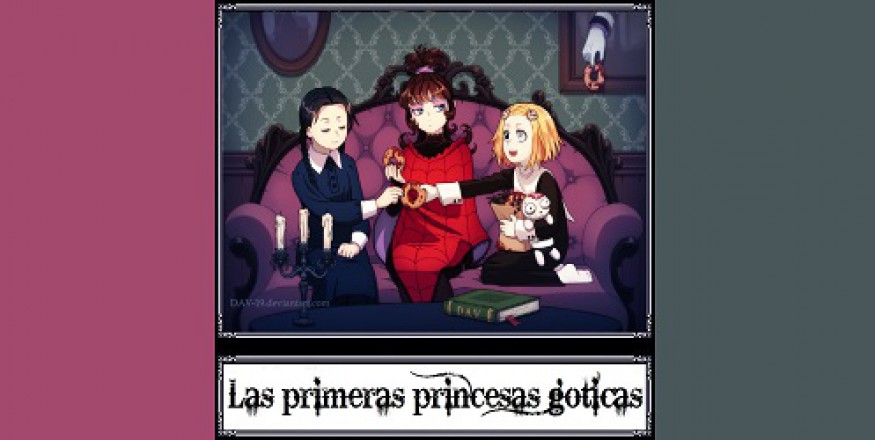THE FIRST GOTHIC PRINCESSES
LYDIA DEETZ
Winona Ryder is the stage name of Winona Laura Horowitz, born in the United States on October 29, 1971.
This actress of Jewish descent whose roots can be seen as far back as Russia and Romania (Dracula's land, and the greatest Olympic gymnasts: Nadia Komaneci and Andrea Raducan), was always very clear that she wanted to be an actress.
.
.
According to the legend... Yes, because the next part seems to be out of fantasy instead of reality, but it really happened:
When she was very young she wanted to try her acting skills and disguised herself as a boy, going to school afterwards. The children finally hit her on the head and made her bleed because she had a very feminine face, but she achieved her goal: none of them knew she was a girl, so she returned home with the bleeding wound as if it were a glorious war wound.
Her parents enrolled her in the prestigious school of dramatic art: The American Conservatory Theater in San Francisco. And some time later she participated in the films: "Lucas" in 1986, where she would play the role of co-star; and then she would participate in the film "Square dance" in 1987, already playing the leading role. Both films and her performance in particular were critically acclaimed, but they were not a box-office success.
It would be her third film that would bring her international fame: Beetlejuice, on March 29-30, 1988. All thanks to three factors:
First, she impressed Tim Burton very much with her performance in the film Lucas; second, Winona Ryder had such a youthful appearance that she could easily play characters much younger than herself, which eliminated the risk of hiring a child actor who didn't know how to perform well in the middle of filming; and third, with her aesthetically perfect face, skin that changed according to the lighting between very white and sickly pale, coupled with the fact that she had huge black eyes that matched such dark hair that nothing had to envy the most popular pre-Gothic actresses, made her the actress to win the casting.
.
.
Director Tim Burton, after directing his first film, which had a very childish aesthetic (like SpongeBob or Jim Carrey's films), wanted to try something new, something that would mix the macabre with comedy, but he wanted to move away from what had previously been done with the Addams or Munster family.
.
.
I have to point out before the Gothic purists point it at me with their middle finger (or with the V of victory but showing me the back of the palm of their hand if they are from the UK), that Tim Burton's film is not a hundred percent Gothic, I would say it has the style: Tim Burton.
Lydia Deetz's character, however, is a hundred percent Gothic. And for those who doubt that she was the first female Gothic character to appear on the big screen, I tell you the following story:
Lydia Deetz wasn't supposed to be Gothic at first! The urban tribe that was in vogue in the early 1980s were the death rockers, immediately prior to the Gothic, as were the beatnicks to the hippies in the 1960s.
Tim Burton took a big risk and chose to leave aside the image of death rocker that Winona Ryder should wear, and instead bet on a new sub-culture, a recent urban tribe that just showed the snout of bats: the English batcavers or Gothic as they called themselves in the United States.
.
.
This was a problem that no one, not even Tim Burton himself, foresaw: What should a Gothic girl look like? It was obvious that she should wear black clothes, but apart from that neither the director nor the producers had any idea exactly what the young actress should look like. It was obvious that their preconceptions and prejudices about this new "urban fashion" had taken them by surprise.
Should they go back to the old concept of a death rocker? Should she dress like Morticia? Turn her into a punk? The project, incredible as it may seem, seemed to be coming to an end for a cause as foolish as the simple choice of costumes.
It would be Winona Ryder herself, who would come up with the solution.
.
.
The bard tells the most inspired nights... That it was the same actress who chose much of the clothes she would wear, in several stores in San Francisco, however, the Gothic fashion was not yet defined and she had to complete the clothing by resorting to old costumes worn by her grandmother. She planned how she should take the whole set in combination and oh muses! The various Gothic costumes that she would wear throughout the filming were born. Lydia Deetz was born.
.
.
Lydia Deetz's name comes from the ancient city of Lydia, which was the first place where coins were made (perhaps an influence on the wealth of the Addams family); on the other hand, the name Deetz, on the other hand, has no meaning, rather it is an aphorism that indicates people who are snobbish with money and who boast their supposed good taste but who fall into ridicule (something right, seeing as Lydia's father and stepmother are).
It was decided that Lydia Deetz would not wear any makeup to separate herself from the previous pre-Gothic actresses. She would wear the hairstyle of the bride of Frankenstein for certain occasions, but not so voluminous and without the white stripe on the side. Her normal hairstyle would be something long and bulky but only shoulder-length, the front would have an elegant High Class style, and the back would fall elegantly in the Booby Cut style.
.
.
Winona Ryder plays a fourteen-year-old girl, who is forced to move from New York to a small town. In the end, however, it is enchanted by the house for a number of reasons: It is Victorian (Gothic); it is located right on top of a high, narrow hill and dominates the view of the surrounding area (an image that would later become popular for haunted houses whether in the cinema, television or video games); and third, it is inhabited by ghosts!
Lydia's character is presented in a very elegant way in the film, sitting on a black couch like a princess or queen. Its Gothic appearance is what most attracts the attention of the ghosts in the house, despite the extravagance of the rest of the family, including a fat guy who invites himself to the move.
Lydia likes the house and shows no aversion to a spider in her web as soon as she gets home. She seems to like photography very much because she has several cameras around her neck, whether they are snapshot cameras or more professional ones to develop them professionally in a dark room, and it is her father who offers to build her a dark room so that she can develop her photographs, which shows that despite her young age she is already very intelligent and mature.
The elegant attitude of the principle is seen as a shield for a girl who is afraid of living in a new place, in addition to being depressed in character, perhaps accentuated by the death of her mother and having a father who is obsessed with work and who does not have (and does not want to) share time with her.
Her relationship with her stepmother is not the best, the woman is simply an insufferable snob who has no intention of getting along with her. Interestingly, both have a macabre taste for art, yet Lydia's tastes are classic and Gothic, while those of her stepmother are modern and contemporary.
Because of the bad relationship she has with her family, she needs a lot of affection and does not hesitate to accept the friendship of the ghosts of the house. These at first try to scare her but she, because she is Gothic, is not afraid of what would scare others, as the ghosts themselves tell her: "At your age a ghost would have frightened me". This shows Lydia's Gothic character as even at first she is hopeful of seeing ghosts full of blood and pus.
Lydia Deetz is very perceptive and therefore does not believe the lies of the evil ghost Beetlejuice tells her.
Artistically, Lydia is a fan of opera as she listens to Maria Callas, the greatest opera singer in a play with a clear Gothic touch: Lucía de Lammermoor, as she writes her suicide letter!
Depressed, she decides to kill herself by throwing herself into the same river where the previous inhabitants of the house died, but when she meets Beetlejuice she decides to make a deal with him (something that is not seen in the film but is supposed to be), the ghost will kill her so that she can meet her ghost friends who apparently left the house in the afterlife.
Although she is insecure in her attitude towards her parents' snobby friends, she later shows the greatest courage and sacrifice of all to save her ghost friends by agreeing to marry Beetlejuice, knowing that the evil poltergeist's intentions towards her are not at all romantic.
At the end of the film you can see a more determined Lydia, although she doesn't give up her Gothic fashion, since underneath her regular school skirt, she wears a black skirt... the same one she personally chose from her grandmother's old clothes.
.
.
The film was an international success, so much so that its aesthetics would be the one adopted by Tim Burton from now on, and it catapulted Winona Ryder to world fame. But undoubtedly the most important aspect is the fact that she has contributed so much to the creation and establishment of the Gothic culture, an aspect which she herself is certainly not aware of.
Universal Pictures created several theme parks for Tim Burton's film in various countries, one of which was Japan. And here's an interesting point:
The Japanese were influenced by the character of Lydia Deetz and created their own Gothic style: The Gothic lolita, which takes two main variations, the one based on the old dolls of the early 20th century but with short skirts; and the more classic one with long skirts, clearly influenced by Winona Ryder and her character Lydia Deetz.
.
.
Lydia's lines:
Delia hates the house (then looks closely at the spider). I could live here.
My life is a darkroom, a big darkroom.
The living ignore the rare and unusual. I'm myself strange and unusual.
I'm alone, absolutely alone.
But I want to die too.
.
.
Curiosities:
At first Winona Ryder did not want to play Beetlejuice, she considered it too "satanic". And she's not to blame, the original script differs greatly from the script used for the filming, as it is completely horror-cut, with mutilations to her character and even suffered a rape.
Lydia Deetz's various costumes are to this day among the most sought-after on Halloween, with several online and physical stores selling them and even video tutorials on how to make up as the gothic girl in the movie.
The red wedding dress that Winona Ryder wears is the most popular at Halloween parties, according to polls.
The two most popular characters in the film, Lydia Deetz and Beetlejuice, were cartooned. The cartoon series, although it takes place in a macabre atmosphere, is lighter than the film, for example Lydia, is still Gothic but her personality is no longer so depressing and suicidal.
In the cartoons, Lydia founds the death rock band: Frankenstein's girlfriends. Funny because Lydia in the original script wasn't Gothic but a death rocker.
The famous actress Juliette Lewis auditioned to be Lydia Deetz, but the role fell to Winona Ryder.
CONTINUARÁ…
ns3.142.124.139da2





















